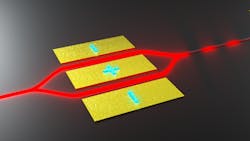Researchers design electro-optic modulators for visible to near-infrared wavelengths
Marko Lončar’s group at Harvard University’s Laboratory for Nanoscale Optics (Cambridge, MA) specializes in developing thin-film lithium niobate (TFLN) devices that operate at telecommunications wavelengths (~1550 nm). But they noticed many applications in fields such as quantum information sciences, sensing, and ultrafast data communications could benefit from visible to near-infrared (VNIR; ~400 to 1000 nm) TFLN devices.
So the researchers designed electro-optic modulators to operate at VNIR wavelengths (see figure and video).
“We’re particularly inspired by opportunities in quantum networking, where VNIR TFLN devices offer ways to efficiently and scalably control individual photons encoded with quantum information,” says Dylan Renaud, a graduate student of applied physics working with Lončar.
The basic principles behind the group’s device are simple. “Our phase and amplitude modulators are fabricated in TFLN,” says Renaud. “Lithium niobate is an electro-optic material, which means that when we apply an electric field to light traveling within a lithium niobate waveguide, we can precisely control the phase of that light. And this is the basis of our phase modulator.”
For amplitude modulators, they use Mach-Zehnder interferometer modulators, which operate in a push-pull configuration. “Instead of having one path along which we apply an electric field, light is now split into the two paths (arms) of the modulator,” Renaud explains. “One arm advances the phase of light, while the other delays it. By recombining these paths after modulating the phase in each arm, we can efficiently control the intensity of the modulator’s output.”
Faster, more efficient VNIR modulators
What makes the group’s modulator work special? Beyond operating at a different wavelength, the researchers show VNIR TFLN devices provide a way to break existing limits on how fast and efficiently VNIR modulators can operate.
“We can use less than 1 V (e.g. 0.55 V at 738 nm) to drive these modulators,” says Daniel Assumpcao, a fellow graduate student in Lončar’s group, also working on visible TFLN devices. “And with relatively little power loss, we can operate these devices up to 35 GHz—35 billion on/off operations per second.”
As a result of their device’s low drive voltage, “we show that our modulators can also be used to deterministically change the color of light traveling through them by a record-setting amount,” says Assumpcao. “To do this, we use electro-optic shearing. In this technique, a quasi-linear phase is applied onto an optical pulse using our TFLN phase modulator. In the frequency domain, this translates to a linear frequency shift. To date, previous demonstrations of this technique have only been able to shift light by a relatively small amount.”
The main reason the researchers’ modulator performs so well is because the lower its drive voltage, the further you can shift the color of pulses of light traveling through it. Since their modulator’s drive is so low, they can produce these larger shifts.
“We’re quite happy with the excellent electro-optic performance—low drive voltages—of these modulators and weren’t expecting it going into the project,” says Renaud. “This excellent performance opens up lots of classical applications for these devices in areas such as sensing, augmented reality/virtual reality (AR/VR), or data communications beyond the quantum applications we originally envisioned them for.”
Modulators for the quantum internet
One key research area in quantum information technology is the quantum internet.
“Just as the classical internet sends classical information between any two arbitrary points within the network, the hope is the quantum internet will enable sending quantum information between any two arbitrary points in the network,” says Assumpcao. “To build up this new network, we need the ability to route and control photons emitted by quantum memory nodes within the network. A majority of the proposed quantum memories emit light at VNIR wavelengths, so the modulators we develop to operate at these wavelengths are a critical piece to the operation of future networks.”
Since completing their modulator work, on the engineering side, the group has already figured out ways to improve the electro-optic bandwidth of these devices to nearly 100 GHz—while maintaining the low drive voltage.
“We’ve also developed fabrication techniques to drastically reduce the on-chip optical loss of these modulators,” says Renaud. “For quantum applications, we’re now working on building large-scale circuits to do things like route individual photons to large numbers of solid-state quantum memories—efficiently convert the wavelength of light, and more.”
FURTHER READING
D. Renaud et al., Nat. Commun., 14, 1496 (2023); https://doi.org/10.1038/s41467-023-36870-w.
About the Author
Sally Cole Johnson
Editor in Chief
Sally Cole Johnson, Laser Focus World’s editor in chief, is a science and technology journalist who specializes in physics and semiconductors.

